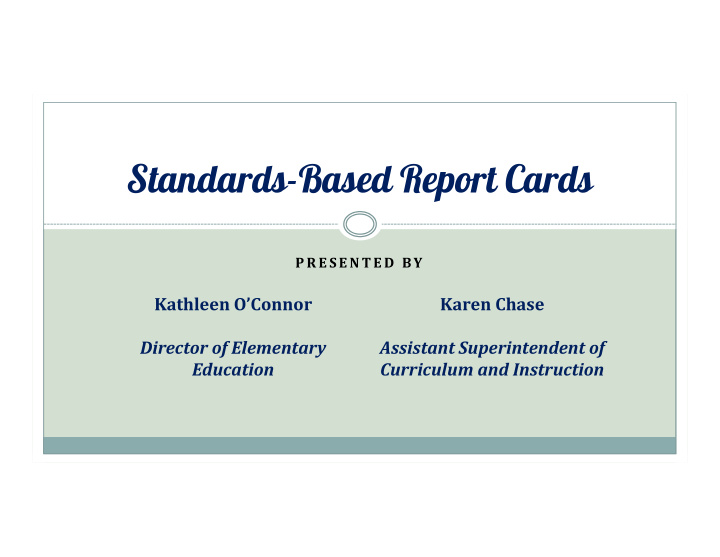



Standards-Based Report Cards P R E S E N T E D BY Kathleen O’Connor Karen Chase Director of Elementary Assistant Superintendent of Education Curriculum and Instruction
Agenda � Purpose � History � Transition � Example of a Standard � Discussion
Defining the Purpose of the SBRC � To communicate information about students’ achievement � To provide information to students for self-evaluation � To select, identify, or group students for certain educational programs � To provide incentives for students to learn � To evaluate the effectiveness of instructional programs (Guskey, 2010)
History 2011 2012 New Jersey adopts the SDoC revises K-5 ELA and Common Core State Math Curriculum to reflect Standards CCSS
History 2013 2015 2014 Teachers implement Revised SBRC shared with LAS implements a SBRC curriculum based on stakeholders Supervisors revise K-3 report CCSS cards based on CCSS • Kindergarten assesses Supervisors present K-3 SBRC SBRC Implemented in Grades CCSS math on report to team leaders/principals K and 1 for feedback card • Two fourth grade SBRC revised according to feedback teachers pilot a SBRC
Transitioning to Standards -Based Comparisons Standards -Based Levels of Proficiency reflect where students stand in reference to specific � expectations for their learning. Standards-Based reporting changes a parent’s perspective from , � � How is my child doing compared to other students in the class? to How is my child doing with regard to the learning standards for this level? In order to promote understanding and facilitate parents’ transition from the previous norm- � referenced report card to the standards-based report card, it is important that teachers provide clear examples of student work at the various performance levels. These examples enhance parents’ knowledge of teachers’ expectations. The Communication Challenge Of Standards-Based Reporting , Guskey, Phi Delta Kaplan, December, 2004
Example of a Standard Assessment Reads sentences 4 fluently Distinguishes letters from words Distinguishes letters from words 3 Identifies some letters and words 2 Not able to identify letters 1
Example of a Standard Assessment Student demonstrates 4 fluency of +/- facts beyond 10 Fluently adds and subtracts within 10 Student demonstrates 3 fluency +/- within 10 Student demonstrates fluency of addition 2 facts to 10 but has limited fluency of subtraction facts to 10 1 Student demonstrates limited +/- fact fluency
What are the Indicators for Achievement? A score of “4” indicates that the student has an advanced understanding and exceeds grade- level expectations as defined by the standard. A student receiving a “4” demonstrates mastery of the specific skill and the ability to apply the skill in ways that go beyond the standard. A score of “3” indicates that the student consistently demonstrates proficient understanding and mastery of grade-level standards and academic expectations. In order to meet grade level expectations, a student should score a "3" by the completion of the academic year.
What are the Indicators for Achievement? A score of“2” indicates that the student demonstrates partial understanding and is progressing toward meeting grade-level expectations. A student receiving a “2” understands the basic concept or skill but has not yet reached the proficient level and/or cannot demonstrate that skill independently. A “2” indicates to parents that their child may need more time to practice and apply that skill or concept. A score of “1” indicates the student does not meet grade-level expectations and is unable to or rarely able to demonstrate the particular skill. A student receiving a “1” is not meeting the grade level standards and interventions may be needed. Proficiency levels of “3” and “2” reflect that a student is working within grade-level expectations.
Thank You For Your Timeu! We value your feedback and appreciate your time. Please contact me any time with questions or concerns. koconnor@chatham-nj.org
Recommend
More recommend